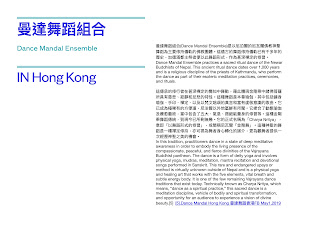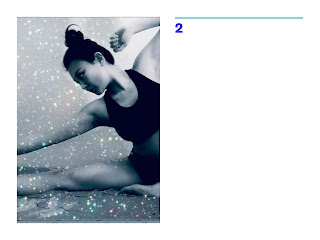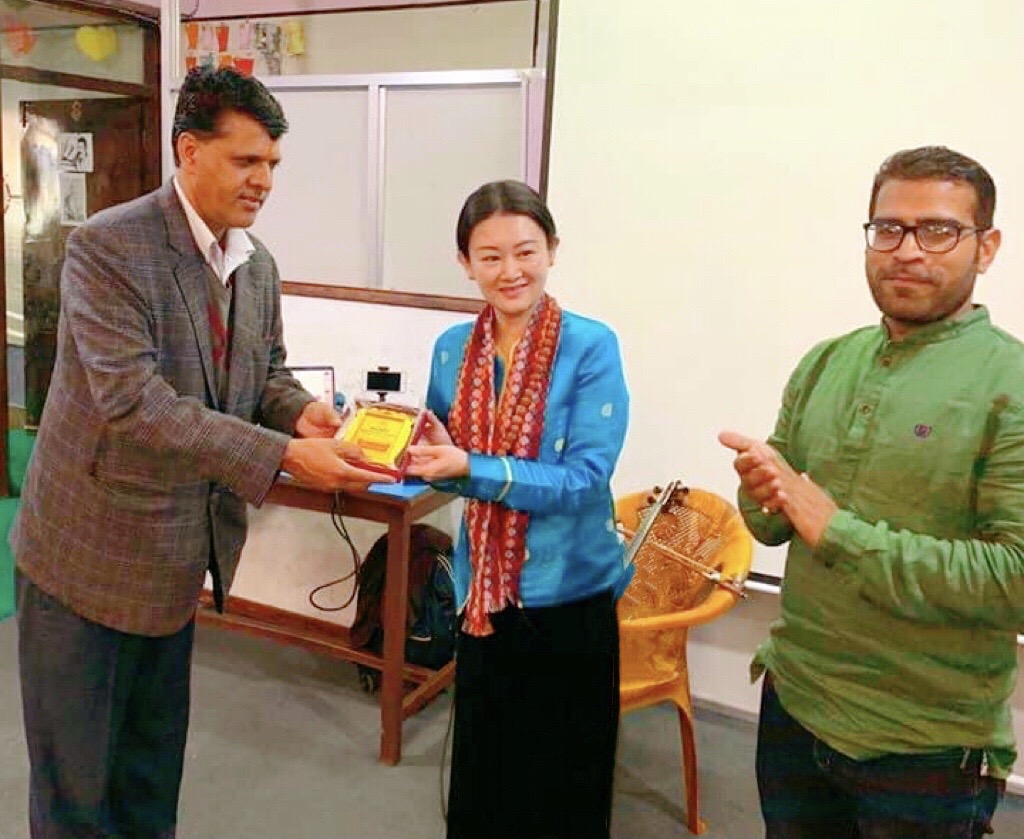🖤 Buddhist Charya Tara, share/promote. Open, this merit is Darn well, to Perfect thing!! why 're u Rejoice in me? Scheduled with Karma Yangjinma (Charya Nritya Handbook ) 喜馬拉雅佛教儀式舞蹈手冊影音指南
撰文 by EV Karma Yangjinma
-Recorded since 2014 🤍
當 我們知道可以依“金剛歌舞”的修持與練習,實踐"七支供養Seven Branches",累積 福慧資糧,這是一種自古以來從藝術修行的方法,解脫道的實踐從歌舞修行。保持覺醒。
回到過去!看!這張老照片是我自藍面人樂隊時代的藝術演奏,因自幼喜愛舞蹈,自我啟蒙之舞來自夢中的臉圖像靈感,25年,沒有人知道它,我把它取名為「Darkness art play for printing in Hollowness」它不是禪 。現在,一場疫情讓人醒思,它從古老的面紗走出來了。2020年我在尼泊爾,訊息顯現了,它在真實的世界!回國後,我開始整理了禪修的尼瓦爾佛教舞蹈,從古老的資料顯示,舞蹈從“身”的內觀指標。緊接著我將無縫接軌,進修並實踐,尼瓦爾古老佛教藝術傳承的禮物,我歡喜並隨喜,供養十方珠寶。以下是佛教金剛行舞的資料。吉祥如意。
「七支供養」,是顯密一致認同的積聚資糧方法,七支供養即普賢十大願行之前七行:禮敬諸佛。廣修供養。懺悔業障。隨喜功德。請轉法輪。請佛住世。普皆迴向。
Seven Branches (Skt. saptāṅga; Tib. ཡན་ལག་བདུན་, yenlak dün) — as Chökyi Drakpa says: "The seven-branch practice (or the seven aspects of devotional practice) incorporates all the key points for gathering the accumulations.
White Tara Dance
7 Branches:
1. prostration, the antidote to pride 頂禮
2. offering, the antidote to avarice 供養
3. confession, the antidote to aggression 發露懺悔
4. rejoicing, the antidote to jealousy 隨喜功德
5. requesting to turn the wheel of Dharma, the antidote to ignorance 請佛轉法輪
6. requesting not to pass into parinirvana, the antidote to the wrong views 請佛不入涅槃
7. dedication of merit, the antidote to doubts 迴向
Charya Nritya: Dancing for enlightenment
The Ancient Tantric Buddhist Dances of the Newari
查里亞舞蹈在亞洲舉辦的噶舉大祈願法會-班雜阿塔曼達學會
File collection was created by Karma Yangjinma
佛教「金剛行舞」發源地-尼瓦爾

Charya Nritya ( Chachaa Pyakhan in Nepal Bhasa ) is a Buddhist ritual dance with a history going back more than 1, 000 years. Charya Nritya(尼泊爾Bhasa的Chachaa Pyakhan)查里亞金剛行舞是一種佛教儀式舞蹈,源自尼泊爾距今已有1000多年歷史。千年以來傳統演出的祭司(上師)僅在法會中進行舞供,是隱而不宣的,對於外界訊息鮮少得知其殊聖之修行含義,近代由於大師們走向國際,已漸漸在世界國際佛教活動及法會儀式中舉行。
Pataka Mudra
by Charya Dance Guru
Pandit AshaKajibajracharya — at Nakabahil
  |
| Charya Nritya |

Charya Nritya (Chachaa Pyakhan in Nepal Bhasa) is a Buddhist ritual dance with a history going back more than 1,000 years. It is performed by Newar Buddhist priests known as Bajracharya as part of their esoteric meditation practices and rituals. The dancers represent various deities like the Five Buddhas, Manjusri, Vajrayogini, and Tara. The song accompanying the dance opens with a salutation and describes the deity's characteristics and accessories. Performances were shown only to the initiated. The first public showing was held during the Fourth World Buddhist Conference held in Kathmandu in 1956.[4]
Charya Nritya (尼泊爾巴薩的Chachaa Pyakhan)是一種佛教儀式舞蹈, 歷史可以追溯到1,000多年. 它由紐瓦爾佛教牧師作為其冥想實踐和佛教法會儀式的一部分演出. 舞者代表各種神性演繹 如五方佛, 曼祖師利, 瓦吉尼和度母. 伴隨舞蹈的歌曲開場講述了其特點和本尊配飾. 表演只向發起人展示. 第一次公開展示是在1956年,在加德滿都舉行的第四次世界佛教大會期間舉行的.
Source: Aesthetic Dance Studio.May3, 2017
Newar dance is performed as part of a ritual and meditation practice known as Chacha Pyakhan ( Charya Nritya in Sanskrit ) and folk dance.紐瓦舞蹈是佛教儀式和冥想活動的一部分,被稱為Chachaa Pyakhan梵語的Charya Nritya。和民間舞蹈。

 由於各種原因,尼瓦爾金剛乘佛教的信仰者們不喜歡公開與自己宗教有關的一些事物,所以加德滿都金剛乘佛教的許多方面得不到宣傳,不為外界所知。對於那些樂於學習研究的學者們他們也不提供方便和幫助。不過現在情況有所改變,黃金寺管理委員會專門為此書做序。以前有些學者也寫過有關黃金寺的文章,但用英文撰寫並全面介紹黃金寺的書,這是第一本。《黃金寺》佛教在印度滅亡之際,印度著名兩大佛學院一些大師逃亡到加德滿都,並在此已有的佛教基礎發展了後期金剛乘佛法和獨具特色的佛教文化。後期金剛乘是在尼泊爾當時的特殊形勢下發展起來的,先後影響過西藏等地的佛教。當時尼泊爾的國王多數信仰濕婆教,個別信仰佛教,即使是信仰濕婆教的國王對佛教也懷有好感,所以佛教在這裡雖然不是統治者的宗教,但也沒有受到壓制。加之尼泊爾人民人種多樣,他們和平共處,相互學習,所以佛教文化在這裡得到了發展。由於政治、經濟和社會壓力的不斷加大,佛教在加德滿都慢慢失去了終生出家制度,而形成了在家修行制度。近百年來,加德滿都的佛教徒在舉行成年儀式的時候象徵性地出家,出家時間越來越短,目前只有四天。由於加德滿都本地的佛教界失去了終生出家制度,從而引起了一些學者們(尤其是西方和印度教學者)的誤解,他們甚至“定論” 加德滿都的佛教並不是佛教,而是佛教的變種。但大乘佛教和金剛乘佛教的學者和信仰者們都知道,在家修行也一樣符合佛法,這是有經典依據的。為舉行各種生活儀式、修行、過節和保護文物,加德滿都主要民族尼瓦爾人在城內修建了許多寺廟。這些寺廟分為大型寺廟 (Mahavihar) 和小型寺廟 (Bahil) 。加德滿都山谷三城市都各有十幾座這種大型寺廟,巴丹市有十八座。各個寺廟特點不同,居住周圍的人們的傳統職業也各具特色。黃金寺就是巴丹市的十八座寺廟之一,它以金剛乘秘宗修行和保存的各種文獻經典而著名。保存在該寺廟的,記錄在植物葉上的歷史文獻很多,目前正在編輯整理之中。該寺廟還保存有用金粉寫在染成深藍色的尼泊爾紙上的般若波羅密多經,這部經典所使用文字是尼瓦爾文字的一種藍澤那,語言為梵文。
由於各種原因,尼瓦爾金剛乘佛教的信仰者們不喜歡公開與自己宗教有關的一些事物,所以加德滿都金剛乘佛教的許多方面得不到宣傳,不為外界所知。對於那些樂於學習研究的學者們他們也不提供方便和幫助。不過現在情況有所改變,黃金寺管理委員會專門為此書做序。以前有些學者也寫過有關黃金寺的文章,但用英文撰寫並全面介紹黃金寺的書,這是第一本。《黃金寺》佛教在印度滅亡之際,印度著名兩大佛學院一些大師逃亡到加德滿都,並在此已有的佛教基礎發展了後期金剛乘佛法和獨具特色的佛教文化。後期金剛乘是在尼泊爾當時的特殊形勢下發展起來的,先後影響過西藏等地的佛教。當時尼泊爾的國王多數信仰濕婆教,個別信仰佛教,即使是信仰濕婆教的國王對佛教也懷有好感,所以佛教在這裡雖然不是統治者的宗教,但也沒有受到壓制。加之尼泊爾人民人種多樣,他們和平共處,相互學習,所以佛教文化在這裡得到了發展。由於政治、經濟和社會壓力的不斷加大,佛教在加德滿都慢慢失去了終生出家制度,而形成了在家修行制度。近百年來,加德滿都的佛教徒在舉行成年儀式的時候象徵性地出家,出家時間越來越短,目前只有四天。由於加德滿都本地的佛教界失去了終生出家制度,從而引起了一些學者們(尤其是西方和印度教學者)的誤解,他們甚至“定論” 加德滿都的佛教並不是佛教,而是佛教的變種。但大乘佛教和金剛乘佛教的學者和信仰者們都知道,在家修行也一樣符合佛法,這是有經典依據的。為舉行各種生活儀式、修行、過節和保護文物,加德滿都主要民族尼瓦爾人在城內修建了許多寺廟。這些寺廟分為大型寺廟 (Mahavihar) 和小型寺廟 (Bahil) 。加德滿都山谷三城市都各有十幾座這種大型寺廟,巴丹市有十八座。各個寺廟特點不同,居住周圍的人們的傳統職業也各具特色。黃金寺就是巴丹市的十八座寺廟之一,它以金剛乘秘宗修行和保存的各種文獻經典而著名。保存在該寺廟的,記錄在植物葉上的歷史文獻很多,目前正在編輯整理之中。該寺廟還保存有用金粉寫在染成深藍色的尼泊爾紙上的般若波羅密多經,這部經典所使用文字是尼瓦爾文字的一種藍澤那,語言為梵文。大型寺廟 Mahavihar是專門為釋迦族Shakya,和金剛師Vajracharya,姓氏的人舉行儀式的寺廟。直至目前,兩種姓都各有自己的出家寺廟。此書作者敏‧巴哈杜爾‧釋迦就屬於黃金寺廟系統。
此書是作者幾年前在泰國召開的佛教寺廟地方特色國際會議宣讀論文的基礎上寫成的,當時該論文被評為優秀論文。書中談到黃金寺的方方面面,每尊佛像的介紹、與該寺廟相關的節日、十二年一度的活動等等。
佛教文學詩與樂隊
Charya Geetika ( poems of Buddhist literature ), written between the 7th to 12th centuries mostly by the poets of Odisha and Bengal, are connected with Tantric Buddhism.
佛教文學詩,主要由奧里薩邦和孟加拉的詩人撰寫,寫於7世紀至12世紀,與密宗佛教息息相關。

Tantric Buddhist Life Music


Dedication
May everyone find a meaningful way to carry on living this life. produce and carry on a meaningful mission.
May all His Holiness, Guru, and Practitioners, Healthy, Long life and Prosperity, and turn the wheel of Dharma. All sentient beings like fathers and mothers are healthy and happy, free from suffering, and find happiness.
迴向,願我的上師,所有教過我及世間出世間的善知識大德,四重恩有情眾生們,長壽健康,吉祥如意!!!
迴向祈願文
索南 迪宜 湯界 息巴尼
以此功德願證佛自性
託涅 涅貝 札南 潘切涅
降伏煩惱怨敵之過患
皆嘎 那契 巴拉 出巴宜
生老病死洶湧之波濤
夕貝 措咧 卓哇 卓哇修
願度眾生解脫輪迴海
Detail Contacting












































留言